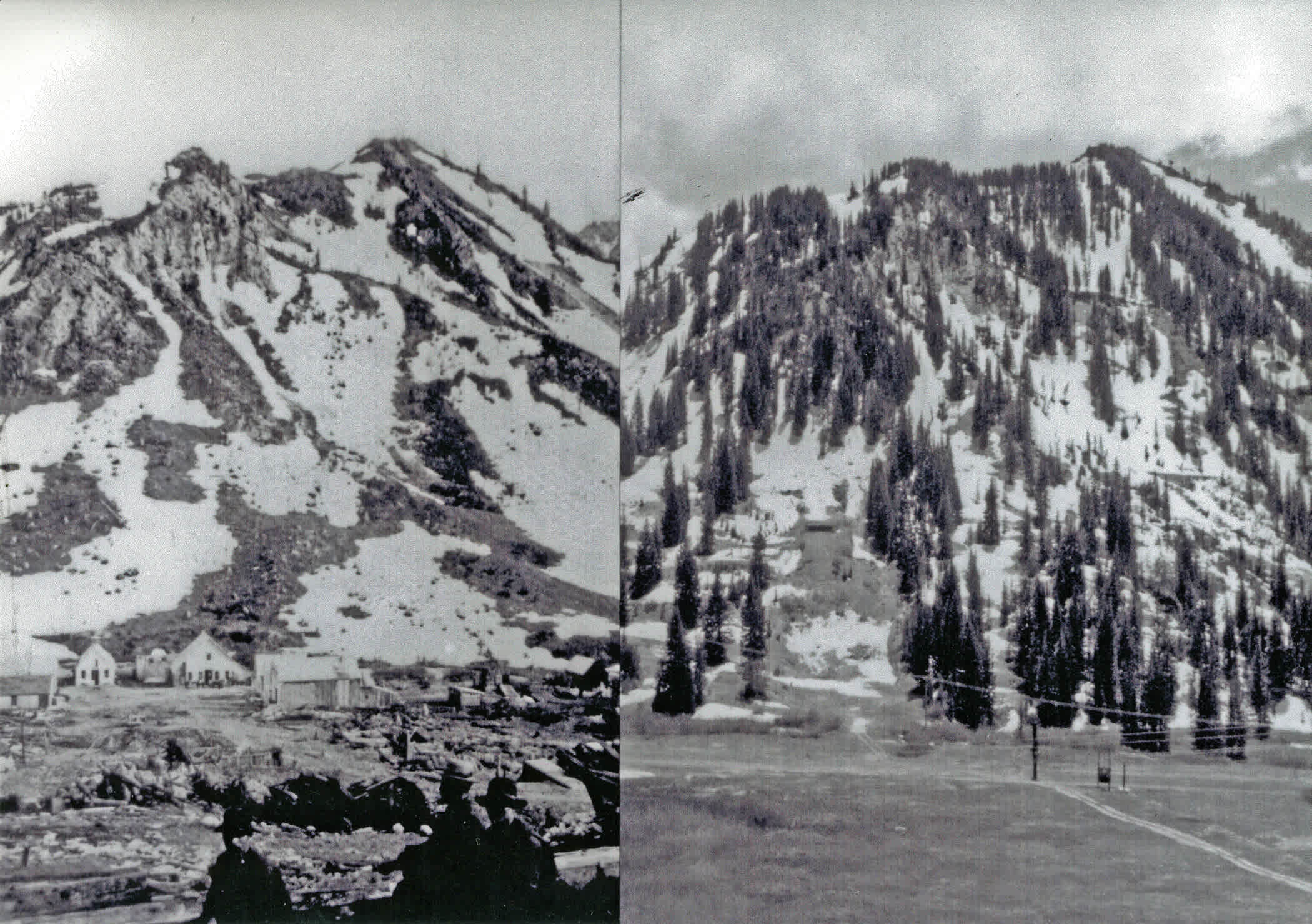wisdom within the grove.
For more than a thousand years, an ancient Limber pine, Pinus flexilis, has stood anchored to a weathered ridge, silently bearing witness to the ever-changing tapestry of life at Alta Ski Area. This tree is a living testament to the tenacity of nature, peering closely at its twisted and gnarled bark one uncovers a story of resilience, symbiosis, and adaptation.

Pinus flexilis anchored over Alta skier | Photo: Rocko Menzyk
Pinus flexilis twists and stretches towards the sky, shaped by harsh winters and dry summers, its roots digging deep into the Wasatch front's ridge. Over time it has forged vital connections with creatures that inhabit this canyon.
The Clark’s nutcracker, Nucifraga columbiana, with its striking black and white plumage, has been a steadfast companion over generations of time. They find shelter in Pinus flexilis’s branches, and their sharp beaks extract its pine nuts that sustain them. In return, they serve as an ambassador to Pinus flexilis, spreading the seeds far and wide across Alta’s landscape. This symbiotic relationship plays a crucial role in the tree’s survival, as the nutcrackers ensure the dispersal of its seeds, helping the legacy of the resilient Limber pine to continue.

A Clark's nutcracker in the top right foraging seeds from a Limber pine | Photo: Rocko Menzyk
In the latter half of Pinus flexilis’s millennium, pioneers ventured into Little Cottonwood Canyon with dreams of prosperity, finding a bounty in the depths of the canyon walls and its dense forest. Tall, straight trees of Engelmann spruce and Douglas fir were the prize, stripped from the landscape until only Limber pines were left. Though ancient and strong, Pinus flexilis did not match the criteria the pioneers were looking for. Its branches, often bent and twisted from the harsh winds, were unsuitable for building with.
So there, along the ridge, Pinus flexilis stood as the echoing of axes hallowed out the forests of Little Cottonwood. As the industry of mining and logging progressed, the canyon displayed scars of a landscape ravaged, the once lush and vibrant forest had been replaced with barren patches of earth.
In the winter, avalanches would come swooshing down the mountainside, ripping apart buildings made from the once tall and strong spruce and fir trees that covered the landscape. Contamination in Little Cottonwood Creek from avalanche debris, livestock waste, and mine tailings flowed down into the valley. Inhabitants began to realize the consequences of overharvesting the precious resources this canyon offered.

Left: CR Savage taken on July 3rd, 1885 | Right: Alan Engen taken on July 12th, 1995 | Photo: Alan Engen Ski History Museum
The rhythmic hum of the ecosystem had been silenced. A century later, a collective understanding emerged and stewards of the land recognized the importance of reclaiming what had been lost. Efforts began to restore the landscape and breathe life back into the stripped mountainside. Pinus flexilis watched as tiny saplings were planted by hand, and began to take root into the once-barren soil. The presence of these new inhabitants was a promise of renewal, Pinus flexilis watched proudly like an older sibling, observing a new generation transform the canyon once more. The saplings grew into sturdy trees, Engelmann spruce and Subalpine fir branches reaching out to one another, weaving a tapestry of life. Birds returned, their songs filling the once-silenced forest.

Volunteer planting an Engelmann spruce sapling during Alta Tree Planting Day | Photo: Rocko Menzyk
Today, Pinus flexilis remains, standing as a guardian of this reborn wilderness, and watches as the landscape flourishes under careful stewardship and diligent revegetation efforts. The Limber pine is a living monument of resilience to the natural world and survival, enduring through the ages of change, and the unwavering bond between tree and bird. As each new ring grows on Pinus flexilis, it brings the excitement of new life, while building upon the wisdom of the past.
In the face of adversity, nature finds a way to thrive, and we look at Pinus flexilis to remind us of the history of this dynamic landscape, understanding the past to help us continue forging a sustainable future for generations to come.
*If you’d like to read more about Alta’s history and revegetation efforts check out our Land Conservation page.

Add Your Comment